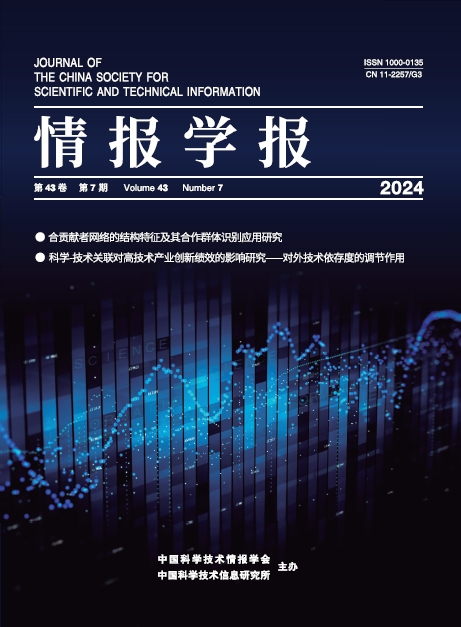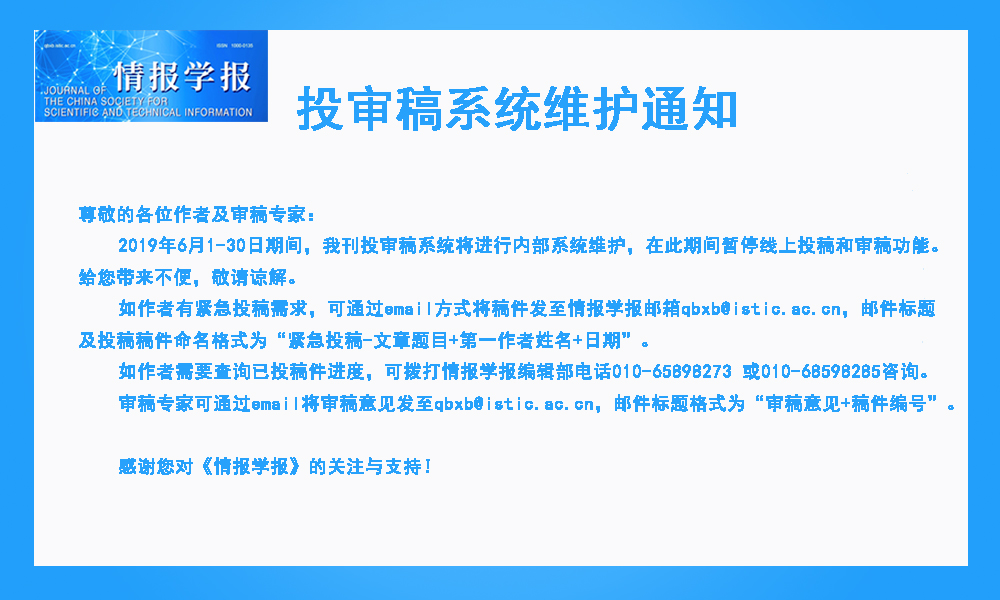 |
|
|
|
|
|
| Intelligence Theories and Methods |
|
|
761 |
Establishment of a Technical Infrastructure System of Science and Technology Intelligence Services in a Complex Information Environment Hot! |
|
 |
Tang Xinglong, Zhang Yu, Zeng Wen |
|
|
DOI: 10.3772/j.issn.1000-0135.2024.07.001 |
|
|
In the current information environment, the scale of data is increasing, and the needs of users have shown diverse personal tendencies. Therefore, new technologies, such as big data, artificial intelligence, and large-scale models, have been gradually involved in scientific and technical services, which not only bring life into the development of scientific and technical intelligence undertakings but also create demand for the establishment of new technical infrastructure systems for scientific and technical intelligence services. From the perspective of the four task types of scientific and technical services, this study illustrates the crucial technical components in science and technology intelligence services and analyzes the difficulties and obstacles of new technologies used in a complex information environment. Using the SWOT (strengths, weaknesses, opportunities, threats) analysis method, this study comprehensively examined four factors, including strengths, weaknesses, opportunities, and threats, as well as the four corresponding strategic dimensions of new technologies used in scientific and technical services. Finally, this study integrates the results of the above local analysis and proposes new content for the current establishment of a technical infrastructure system, hoping to support the sound development of the entire technical ecology of scientific and technical intelligence services. |
|
|
2024 Vol. 43 (7): 761-772
[Abstract]
(
315
)
HTML
(123 KB)
PDF
(1126 KB)
(
335
) |
|
|
|
773 |
Structural Characteristics of the Co-contributorship Network and Its Application in Collaborative Group Identification Hot! |
|
 |
Lu Chao, Li Mengting, Chen Xiujuan, Dong Ke, Wei Ruibin |
|
|
DOI: 10.3772/j.issn.1000-0135.2024.07.002 |
|
|
The construction of organized scientific research teams relies on a scientific understanding of the phenomena and patterns of research collaboration. The commonly used research model for scientific collaboration, the co-authorship network, assumes equal contributions among co-authors for the same research output, which often contradicts actual research collaboration practices. The emergence of author contribution statement data provides valuable material for revealing more detailed collaboration practices. This study proposes a novel collaboration network, which is called the “co-contributorship network” and constructed using contribution declaration data, to provide a new tool for investigating scientific collaboration issues in depth. Using article data in the field of medicine from PLoS as an example and the co-authorship network as a baseline, we explore the physical properties of this new collaboration network through its network structure characteristics. Furthermore, we focus on identifying collaboration groups, an essential research direction, to better understand the practical value of the co-contributorship network. The study finds the following: in terms of the network structure, the co-contributorship network is sparser than the co-authorship network. The results of both networks regarding the identification of collaboration groups partially coincide, with an overlap of approximately 57%. Approximately 32% of the collaboration groups experienced restructuring in the co-contributorship network. The evaluation results show that collaboration groups in the co-contributorship network tend to be more focused on research topics compared to those in the co-authorship network, but the difference is not statistically significant. Overall, based on our dataset, the co-contributorship network exhibits a more favorable community structure compared to the co-authorship network. It helps identify finer-grained collaboration groups with higher consistency in their research topics among the identified groups. |
|
|
2024 Vol. 43 (7): 773-788
[Abstract]
(
162
)
HTML
(161 KB)
PDF
(5778 KB)
(
503
) |
|
|
|
789 |
Research on High-Level Paper Selection from Citation Review Evidence Perspective Hot! |
|
 |
Ma Ruimin, Feng Yumei, Song Guoqing |
|
|
DOI: 10.3772/j.issn.1000-0135.2024.07.003 |
|
|
A paper is an important expression of scientific research results. It is crucial to scientifically select high-level papers under the current background of “breaking the five-only” approach, which is the basic starting point to ensure the implementation of representative work evaluation. Citation comments by the academic community are the most direct form of recognition of a paper’s value and serve as substantive and critical evidence of academic evaluation. Analyzing citation content more deeply helps to discover high-level papers more scientifically. First, this paper explains the basic idea of model construction based on the theory of academic identity and the characteristics of evidence. Second, it redefines and classifies citing emotions and citing functions based on content semantics, and fully considers the “citing author’s credibility.” This leads to the construction of a comprehensive weighted selection model for high-level academic papers. Third, relevant papers from Angewandte Chemie-International Edition, a top journal in the field of chemistry, are selected for empirical research. The results show that the model proposed in this paper accurately identifies “Very Important Papers (VIPs).” Finally, compared with other mainstream evaluation indexes, the model demonstrates a high degree of differentiation and discrimination, significantly improving the evaluation of the academic level of a paper. |
|
|
2024 Vol. 43 (7): 789-801
[Abstract]
(
178
)
HTML
(157 KB)
PDF
(2624 KB)
(
329
) |
|
|
|
802 |
Explainable Paper Recommendations Based on Heterogeneous Graph Representation Learning and the Attention Mechanism Hot! |
|
 |
Ma Xiao, Deng Qiumiao, Zhang Hongyu, Wen Xuan, Zeng Jiangfeng |
|
|
DOI: 10.3772/j.issn.1000-0135.2024.07.004 |
|
|
Paper-recommender systems aim to recommend the most relevant academic papers for researchers from the vast academic resources. Existing paper recommendation methods are mainly based on the textual information of papers or citation relationships, failing to make full use of the rich semantic information in heterogeneous academic graphs, thus leading to less accurate recommendation results. In addition, existing methods focus more on recommendation accuracy and neglect interpretability, which decreases the reliability and user satisfaction of the paper recommender systems. To solve these issues, this study proposes an Explainable Paper Recommendation (EPRec) method based on heterogeneous graph representation learning and the attention mechanism. First, an attention mechanism-enhanced heterogeneous graph representation learning-based paper recommendation module is proposed to incorporate multi-source side information from heterogeneous academic graphs. Then, the interpretable text generation method is introduced into the paper recommendation scenario. A feature-based text generation module is proposed to generate textual interpretation to explicitly provide recommendation reasons to researchers. Finally, we construct an academic dataset that contains multi-source information, including paper metadata, feature words, and citation contexts. The experimental results show that EPRec performs better than the comparative methods in terms of precision and recall. Moreover, EPRec provides high-quality, interpretable text explanations for the paper recommendation results. |
|
|
2024 Vol. 43 (7): 802-817
[Abstract]
(
228
)
HTML
(244 KB)
PDF
(2897 KB)
(
414
) |
|
|
|
818 |
The Measurement, Evolution, and Relationship between Country Disparity and Team Impact Hot! |
|
 |
Liu Meijun, Bu Yi, Yang Sijie |
|
|
DOI: 10.3772/j.issn.1000-0135.2024.07.005 |
|
|
International scientific collaboration has become an important avenue for knowledge creation that contributes to scientific breakthroughs. International collaboration not only reflects the cooperative motivations of individual scientists but also demonstrates the interdependence and cooperation among countries in socio-economic and scientific activities. In this study, we explore the relationship between country disparity and team impact by examining the national attributes of the team members of scientific publications. First, we quantified the “distances” between countries along various dimensions such as geography, economy, culture, and scientific activities, and applied principal component analysis to extract three main components of the comprehensive disparity among countries. We then examined the associations between the three disparity scores and team impact. The findings reveal significant negative correlations of cultural disparity and research investment disparity with team impact. Conversely, there is a significant positive correlation between collaboration disparity and team impact. These research findings hold policy implication for the formulation, maintenance, and management of international scientific teams and are expected to contribute to improving the performance of international teams. |
|
|
2024 Vol. 43 (7): 818-838
[Abstract]
(
181
)
HTML
(262 KB)
PDF
(4563 KB)
(
379
) |
|
|
| Intelligence Technology and Application |
|
|
|
|
850 |
Research on the Configuration Path of the Effectiveness of Smart Government Intelligence Decision-making for Major Emergencies Hot! |
|
 |
Pang Yufei, Zhang Haitao, Zhang Xinrui, Liu Yanhui |
|
|
DOI: 10.3772/j.issn.1000-0135.2024.07.007 |
|
|
From the perspective of responding to major emergencies, we explored the connotations and characteristics of the effectiveness of smart government intelligence decision-making and analyzed the influencing factors and conditional variable combination paths of the effectiveness of smart government intelligence decision-making, which is conducive to the optimization of smart governments and proper responses to major emergencies. Guided by the security system theory and WSR (wuli-shili-renli) methodology, first, through an extensive review and analysis of the relevant literature, we defined the connotation and characteristics of the government intelligence decision-making effect and then sorted out the conditional variables influencing the effectiveness of government intelligence decision-making. We collected relevant data through questionnaires and then used the fuzzy set qualitative comparative analysis law method to comprehensively analyze the combination path of influencing factors and conditional variables. By studying the impact of different variable factors (e.g., decision-making information anxiety, information transmission barriers, emergency network public opinion, emergency response, information infrastructure construction, laws, regulations, and system construction) on the intelligence decision-making effect of a smart government, we finally obtained five combination paths: the information transmission barrier missing path; information anxiety factor dominated by the reason factor, law, and system factor fusion path; the path of lacking information anxiety; the path of integrating information transmission barriers dominated by rational factors with regulatory and institutional factors; and the path of specialized regulatory and institutional factors. These paths can provide a reference for improving intelligent decision-making and emergency responses in smart governments. |
|
|
2024 Vol. 43 (7): 850-861
[Abstract]
(
166
)
HTML
(141 KB)
PDF
(1377 KB)
(
391
) |
|
|
|
862 |
Knowledge Element Logical Relation Extraction Method Hot! |
|
 |
Cheng Wei, Zheng Dejun, Zhu Mengdie, Cong Tianshi, Wang Yanhong |
|
|
DOI: 10.3772/j.issn.1000-0135.2024.07.008 |
|
|
The extraction of knowledge element logical relation focuses on the syntactic structure and syntactic features of the context and realizes context-scoped relation extraction by defining trigger word rules through contextual functional semantic dependencies. To eliminate the structural limitation of context, this study proposes a new method for the extraction of knowledge element logical relation. First, based on the domain literature, the knowledge element collection is constructed through knowledge element extraction. Second, based on the domain knowledge characteristics, a knowledge element attribute description framework is constructed to provide an all-round and fine-grained unified description of knowledge elements, and the knowledge element attribute collection is constructed based on knowledge element attribute extraction. Finally, the logical relation types are defined in accordance with the actual needs. Through logical relation instance analysis and attribute comparative relation analysis, the logical relation rule base is constructed via characterization and summarization. This is done by taking the basic relations, such as co-occurrence, inclusion, and correlation of attribute values, as clues, and the logical relation extraction is realized through rule matching. Considering the South China Sea rights protection evidence knowledge element, some evidence from different text sources are selected, and the types of logical relations between evidence and their extraction rules are defined. Based on the extraction of knowledge elements and their attributes, the logical relation extraction between the South China Sea rights protection evidence of juxtaposition, succession, rebuttal, and reinforcement is realized based on rule matching, and the logical relation mapping of the South China Sea rights protection evidence is constructed. The feasibility of the proposed method is empirically verified, which can provide new ideas for research on the logical relation extraction of knowledge elements. |
|
|
2024 Vol. 43 (7): 862-874
[Abstract]
(
172
)
HTML
(128 KB)
PDF
(3692 KB)
(
304
) |
|
|
|


